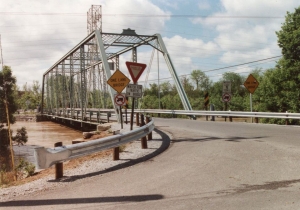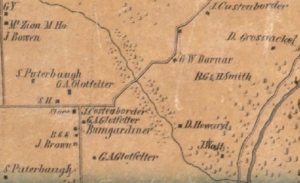Book
Displaying items by tag: Distillery
Having acquired the distillery built by Jonathan Snyder in 1841, F.C. found the production of whiskey quite profitable. In the 1870’s it had a capacity of 226 barrels and a daily output of 800 gallons! Once, Mr. Trebein persuaded an inspector to let him continue to operate a boiler longer than he should. Two employees, Mr. Gordon and Mr. Potter went to the furnace room for a drink of the libation, when through the door the boiler exploded and shot through the roof. Both men were fatally scalded.
Years later, the Colonial Distillery Company tore down the old distillery and built a larger one with a dry house to dry the mash into livestock feed. After only a few years, this caught fire and burned the distillery completely down. It was never rebuilt.
Note the newspaper clipping below describing the intoxicated fish following the distillery fire!
A covered bridge spanned the river to the north. It was eventually replaced with a steel one-lane bridge that survived until the 1990’s.
 Colonial Distillery Fire
Colonial Distillery Fire
Colonial Distillery Fire
Colonial Distillery Fire
 Drunk Fish
Drunk Fish
Drunk Fish
Drunk Fish
 Former Bridge Location
Former Bridge Location
Former Bridge Location
Former Bridge Location
https://www.beavercreekliving.com/book/itemlist/tag/Distillery#sigProIdd6c47a6f39
Prior to U.S. Route 35, turn left on Heller Drive and then right on Orchard Lane. Cross U.S. Route 35 and turn right on Yellow Brick Road.
The bridge over the Beaver Creek is the approximate location of Mr. Harbine’s distillery. The mill dam, just north of the existing highway, divided a mill race from the main creek. With this rudimentary dam they could control the flow to the water wheels that powered the mills. Once the mill era passed, the new leg was filled in, and is somewhat viewable in the basin on the north side of the bridge.
Construction of the US-35 highway completely altered the land as it was, but remnants of the mills can still be found just below the surface!
The Harbine Distillery was initially constructed during a time when distilling was an accepted and honored profession. Grist and saw-milling, hog raising, and pork packing were ancillary industrial concerns that made efficient use of the infrastructure and byproducts of the distilling process. Temperance and the development of a widespread and functional railroad system precipitated the decline of this industrial system by the mid-1800s. The crushing blows to rural distilling occurred during the Civil War, when federal excise taxes soared from nothing to $2.00 per proof gallon on whiskey and other distilled spirits. By 1868, when the excise taxes were finally reduced, most of the rural whiskey making ventures had either suspended production or simply ceased. The advent, operation, and demise of the Harbine Distillery parallels the once widespread rural practice of whiskey distilling, an extinct and largely forgotten feature of the American landscape.
** Below you can download a copy of 'The Distiller's Tale' - an archaeological dig at the Harbine distillery **
https://www.beavercreekliving.com/book/itemlist/tag/Distillery#sigProId251ea64e4d
As you reach the intersection at Swigart Road, two generations of the Bumbardner family operated a blacksmith shop at the corner. The older homes in this area all c. 1900. Turn right. The 187 acre Jonathan Snyder farm encompassed much of the land on the north side of the road to Indian Ripple Road. In 1841, Jonathan operated the original distillery in the town of Trebein, which was later owned by F.C. Trebein.
Continue around the curve and beyond Sperling Lane to the intersection at Indian Ripple Road.
Navigation
Latest Blog Posts
- Just Don't Call Us Late For Dinner...
- Remember When...
- What A Long, Strange Trip It's Been...
- Snow Down = Slow Down
- School Bus Safety - Just Do It!
- Stevenson Road Covered Bridge
- Our Road Crews Are Worth Their Salt!
- The Most Colorful Of Seasons!
- Popcorn Fest! - Then And Now
- Pre-School Paradise!
- Remembering Riffles
- Ten Year Anniversary Of The Beaver Statues







